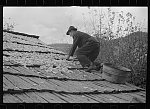At this point in the project, I have started to think about how I will use my digital exhibits in a lesson plan for teacher use on the teacher’s resources page on my Omeka site. I have done a bit of research about what kind of activities teachers use when they teach the Great Depression unit in the classroom. I will more than likely craft a lesson plan for the middle school level as well as for the high school level for teacher use. I need to do a bit more research on middle school US history lesson plans as I am proficient at the high school level and less so at the middle school level.
The primary sources that I used in the digital exhibits are from the Farm Security Administration – Office of War Information Photograph Collection that is housed at the Library of Congress. The set of photographs I used is primarily photographed by Arthur Rothstein in 1935 in Shenandoah National Park. The challenge with this set of sources is that there is not a ton of information about the people and/or places that are photographed. Often the title of the photos does not provide much context about the specific image. I have to rely on my other knowledge about the topic and people to fill in the gaps in the photos. I may look for another set of primary sources to also fill in the blanks, I do know of another archive that has photos from the same time and of the mountain people that were taken by different photographers. These images are not currently digitized so that would require an extra step to use them in this digital project.

Above is an image titled “Drying apples, one of the few sources of income for the mountain folk, Shenandoah National Park, Virginia”. I chose this image because it shows how the mountain people learned to adapt to their surroundings during a time of environmental and economic crisis. This image goes against the stereotype that these “mountaineers” were lazy and ‘shiftless’, many of the people living in the mountains were resourceful and hardworking even when all odds were against them. I would use this image in the conversation about the stereotype of the mountaineer and how it contradicts that stereotype. This image is part of the digital exhibit “Mountaineers” and is under the ‘Defying the Stereotype’ tab which expands further on this topic of how the mountain people often defied this common misconception about them. It helps to frame out the larger question of why did 1930s America have this view about the mountain people that resided on the land that became Shenandoah National Park.